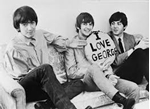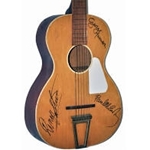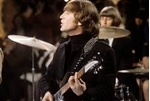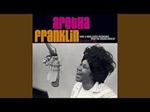- Register
- Log in to Tune-In
- Wishlist (0)
-
Shopping cart
(0)
You have no items in your shopping cart.
Beatles News

THE BBC banned three Beatles songs during their musical career - but the broadcasters were especially outraged with the hit ‘I Am The Walrus'.
John Lennon . ‘Lucy In The Sky With Diamonds’ was also banned for drug references too as a form of censorship by the broadcasting house. JUST IN: The BBC banned multiple songs by The Beatles – but one particularly annoyed the band (Image: GETTY) George Harrison was particularly frustrated by the decision to ban 'I Am The Walrus' (Image: GETTY) ‘I Am The Walrus’ suffered the same fate that year, as their two other songs, and was banned by the BBC. The corporation did not like the lyrics “Crabalocker fishwife, pornographic priestess” and “Boy, you've been a naughty girl you let your knickers down." In that era, Mentalfloss claimed that the word “knickers” and the “obvious reference to sex” was “all too much for the airways” in 1967. The Beatles were allegedly outraged by the decision not to allow their songs to be broadcast on the BBC – especially George Harrison who spoke out in an interview. DON'T MISS Read more: Daily Express.
Source: headtopics.com

As the coronavirus pandemic spreads across the world, it’s understandable that health and economic worries are increasing. To help keep spirits high, Queen and Adam Lambert’s Brian May has been encouraging his fans to think positive by sharing some track clips on his Instagram. One of the more recent ones saw him use a bit of The Beatles legend George Harrison’s All Things Must Pass.
Source: George Simpson/express.co.uk
details
hen The Beatles were in the height of their fame, they excitedly managed to meet American superstar and the king of rock and roll Elvis Presley. In a series of interviews compiled in a YouTube video in recent years, band members John Lennon, Paul McCartney, Ringo Starr and George Harrison all reflected on the incredible opportunity. But Starr admitted the experience has been tainted, as he claimed Presley tried to ban them from entering the USA in the years following their initial meeting.
“He was just surrounded by these sycophants,” Starr recalled initially of the meeting.
“[Elvis would say] ‘I’m gonna go to the loo now’, [they would say] ‘Oh ok we’ll all go to the loo with you’.
“It was just so strange, and I was just so angry because he wasn’t making any music.
Source: Roxanne Hughes/express.co.uk
details
During an appearance on Scars & Guitars, fusion guitar champion Al Di Meola (Return to Forever, solo) talked about his new The Beatles tribute album "Across the Universe."
The record was released on March 13 via earMusic, featuring a collection of 14 tracks. You can stream it in full in the embedded player below. Discussing what The Beatles meant to him, Al commented (transcribed by UG):
"The Beatles were highly inspirational to me, as a lot of the English music was. But they set the bar. Everybody was trying to make music, not to better them, but The Beatles - they set the benchmark.
"Then when they went off on their solo things, I definitely lost interest in their solo stuff, which led me onto the path that brought me into whatever prominence they still got because I went down the road into jazz-rock, fusion, and everything.
Source: ultimate-guitar.com/jomatami
details
A builder could be £10,000 richer after finding papers in a skip that included sketches Sir Paul McCartney commissioned for his psychedelic piano.
Andy Clynes, 54, from Oldham, was overseeing a development at a mill near Manchester when the papers were thrown out with other waste.
He took them out of the skip and stored the papers in a box in his loft for around 20 years until deciding recently to see what they are worth.
An auction house is now selling the highlight of the find, the sketches and designs for the Beatle's so-called "magic" piano.
More of the papers from his find will go under the hammer in a separate sale later this year at Omega Auctions, with the total expected to fetch £10,000.
I picked them out of the skip.
"The case burst open as it was thrown in. It was raining and I just picked up what I could."
Source: itv.com
details

The Beatles had plenty of hits. They even had plenty of hits after they stopped being the Beatles. However, false rumors may have helped one of the Beatles’ post-breakup songs become a hit.
There’s a first time for everything. In the late 1980s, George Harrison wanted the surviving Beatles to reunite for one of his music videos. He lied to make sure everyone thought that happened.
Aside from the infectious hit “Got My Mind Set on You,” the most famous song from George’s 1987 album Cloud Nine is “When We Was Fab.” “When We Was Fab” is a meditation on the Fab Four’s time together. It features some lyrical references to the Beatles songs. The song’s beat resembles that of “I Am the Walrus.” “When We Was Fab” also has some Indian instrumentation, recalling George’s composition “Within You, Without You.”
Source: cheatsheet.com
details
Handwritten lyrics of the Beatles’ iconic hit Hey Jude, John Lennon’s corduroy trousers, and a wooden stage that the British band performed on – these are just a few of the highlights that went under the hammer in New York on April 10.
Titled “All Beatles“, the sale by Julien’s Auctions marked the 50th anniversary of the Beatles’ dissolution. It featured some 300 items of never-before-seen memorabilia spanning the Fab Four’s 30-year career, including instruments, autographed items, rare vinyls, obscure licensed material and other collectible artefacts.
Among them was a wooden stage of the Liverpool venue where Lennon, Paul McCartney, George Harrison and former bandmate Stuart Sutcliffe performed as The Silver Beetles in May 1960. The stage was later removed from Liverpool’s Lathom Hall, where the Beatles performed on ten more occasions without Ringo Starr on drums until February 1961. This historical memorabilia is hitting the auction for the first time at Julien’s Auctions, where it is expected to sell for between US$10,000 and US$20,000 (320,000 THB and 640,000 THB).
Source: prestigeonline.com

When you dig into the history of The Beatles, you see the influence of rock ‘n’ roll pioneers Little Richard, Elvis Presley, Chuck Berry, and Jerry Lee Lewis. But the list wouldn’t be complete without Buddy Holly (1936-59).
“Buddy Holly was the first one that we were really aware of in England who could play and sing at the same time,” John Lennon said in an interview later published in Beatles Anthology. “Not just strum — but actually play the licks [and sing]”
Paul McCartney also noted what a major influence Holly was. “One of the main things about The Beatles is that we started out writing our own material,” Paul said. “People these days take it for granted that you [write], but nobody used to then. John and I started to write because of Buddy Holly.”
When John and Paul (then as The Quarry Men) first recorded anything, a cover of Holly’s “That’ll Be the Day” was how they got started in 1958. Over the years, The Beatles would play many more Holly songs. But they only ever recorded one Holly track for a Fab Four studio album.
Source: cheatsheet.com

Fans remember Lennon as an icon, but those working for the FBI may recall the musician's reputation a bit differently.
For many, the face of John Lennon is directly associated with the peace and love that circulated during the hippie movement of the late 1960s and early 1970s. Music fans will remember him as one of the most iconic members of The Beatles, founding the group and a songwriting career that has yet to be rivaled. However, those who were working for the FBI under J. Edgar Hoover may recall the musician's reputation a bit differently.
In March of 1969, John Lennon and Yoko Ono were on a European mission to be married. After a failed attempt in the U.K and another unfortunate technicality in Parisian nuptial law, the couple finally found a beautiful location at The Pillar of Hercules in Gibraltar.
Source: Vinnie Rossiello/thethings.com
details

Who would have known the lasting impact two unconnected events of 5 October 1962 would have?
On certain days, the stars are in some mysterious alignment. Like 5 October 1962, when two unconnected events took place, which would have massive and everlasting global impact. It was the day the first Beatles single Love Me Do and the first James Bond film Dr No were released.
The Beatles are, without doubt, the most influential music band of all time. And, it is estimated that 20% of the world’s population has watched at least one Bond movie. Yesterday, the most covered pop song ever, has been sung by people as diverse as Elvis Presley, Aretha Franklin, Placido Domingo and Boyz II Men. And, of course, Bond keeps going on and on, with the 25th official film, No Time To Die, set to release this year.
Source: Sandipan Deb/livemint.com
details
A busker was left "absolutely speechless" after a man who dropped money in her guitar case outside a busy London station turned out to be Sir Paul McCartney.
Charlotte Campbell was singing outside Charing Cross station when a passer-by stopped to listen to her singing one of her own songs.
It was only when 77-year-old Sir Paul dropped some coins into her case that she looked up and realised the Beatles legend was standing in front of her.
The full-time musician, 30, was “absolutely speechless” at first but managed to utter “thanks Paul” as he turned away.
She then sang one of his hit songs “I want to Hold Your Hand”, to which Sir Paul turned around and gave her a smile and a thumbs up.
Source: Ellena Cruse/standard.co.uk
details
The Beatles are renown as perhaps the most experimental group ever to reach a large, mainstream audience. However, they got their start as conventional pop idols. One of their hits from their pop idol period was “Do You Want to Know a Secret.”
Many aspects of “Do You Want to Know a Secret” set it apart from other Beatles song. One unique aspect of the song is that its original version featured a toilet flushing. Another is that is was one of the early tunes sung by George Harrison.
John wrote “Do You Want to Know a Secret.” He recorded a demo of the track in a restroom at a German nightclub. He felt this was the only place quiet enough for him to record the demo. At the end of the demo, he flushed the toilet – an encapsulation of his cheeky humor. Sadly, the demo is lost forever.
Source: cheatsheet.com
details
All Cirque du Soleil productions have fantastic visuals, but The Beatles LOVE may be the one that actually sounds the best. The show features dancers, acrobats, and aerialists performing to the iconic music of the Fab Four. From “I Want to Hold Your Hand” to “All You Need is Love,” the band’s material has never been more crystal clear, booming from an immersive sound-system in a custom-designed theater inside The Mirage. The original recordings were remixed with the help of the Beatles’ late producer George Martin in reimagined, mashed-up form.
Source; Robert Kachelriess/lasvegasmagazine.com
details
From the January 2019 announcement that Peter Jackson was working on a new Beatles documentary, we started hearing the narrative that it would be an answer to Let It Be (1970), the contentious doc produced by Michael Lindsay-Hogg from early ’69 Fab Four sessions.
Digging into 55 hours of unused footage — and more than twice that amount of audio material — Jackson said he’d found a different side to what we’ve considered the most bitter of Beatles days. According to the director, the footage would change everyone’s conception of those sessions.
“I was relieved to discover the reality was different to the myth,” Jackson said. “Sure, there’s moments of drama — but none of the discord the project has long been associated with.” For those who recalled the George Harrison-Paul McCartney flap in Let It Be, this claim sounded interesting.
Jackson wasn’t the only one who’s made these claims. Along with Paul, Ringo Starr has gone on the record saying the Fab Four was doing quite well when it appeared otherwise.
Source: cheatsheet.com

“Let It Be” is one of the most famous songs the Beatles ever released. It’s easy to see why. The song’s combination of soul, gospel, and pop music helps it to connect with many different types of music fans.
Surprisingly, the Beatles were not the first artists to release their version of the song. Aretha Franklin’s version was released shortly before the Fab Four’s. Franklin is largely responsible for her version of the track languishing in obscurity.
“Let it Be” was written for the Beatles’ album of the same name. Like many Beatles songs, it was inspired by the work of another artist. In this case, Franklin inspired Paul McCartney to write “Let It Be.” The track was written in 1969, near the end of the sessions for its parent album.
Franklin wasn’t just the inspiration behind the song. Paul sent a copy of it to Jerry Wexler, a producer for Atlantic Records. He wanted Franklin to record a version of the song. Wexler said it’s highly possible Paul wrote the song specifically for Franklin.
Source: cheatsheet.com
